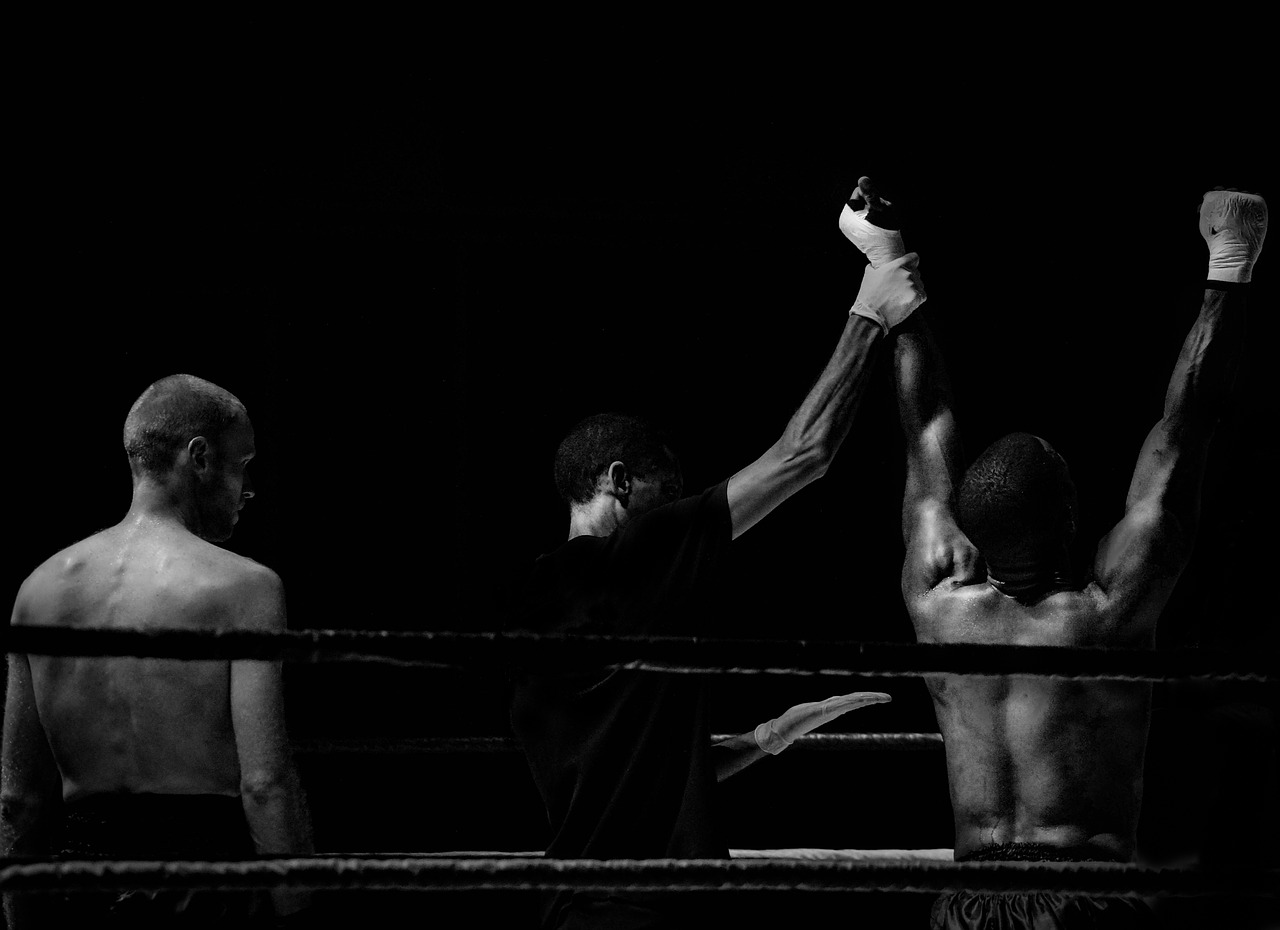Fear and boxing go together like a jab and a cross. Training and competing in the sport brings forth a lot of scary “firsts” – pushing yourself to new places physically, hitting and getting hit, and performing in front of huge crowds.
Boxing’s scary side makes it a very effective vehicle for human development, but being afraid isn’t very conducive to learning or performing at a high level. If you want to get better fast and fight to your full potential, you’ll need to know how to relax in boxing.
In Sam Sheridan’s The Fighter’s Mind, legendary boxing trainer Freddie Roach joked that he “skipped the fear because he started so young.” That’s great for him, but most of us weren’t boxing for as long as we’ve been alive.
Don’t worry – there’s hope for you yet. Read on for four tips on how to relax in boxing.
1) Outline Positive, Active Goals for the Fight
You can’t relax until you accept that some things are out of your control in a fight. Nobody’s going to argue that advice, but I see novice and veteran fighters ignore it every day.
Most fighters go into fights focused on technique and strategy, which is great, but they often frame their thoughts in a negative, passive way that actually adds stress.
Don’t get hit. Don’t let him cut you off. Don’t gas out.
The problem here is that each of these goals outlines something not to do. It’s a negative way of thinking that diminishes the control you have over the situation at any given moment. Besides, this is boxing – you’re going to get hit, you’re going to get cut off, and you’re going to get tired. What happens mentally when you fail to hit any of the goals you set out for the fight?
Instead, try to frame the same basic strategic goals in a way that is active and positive:
Move your head. Create angles after every exchange. Breathe and create opportunities to rest.
The strategies are the same, but now the fighter has actionable, active goals to focus on, instead of worrying about the things their opponent is trying to do – hit them, cut them off, and tire them out. This approach emphasizes your control and puts you in the frame of mind needed to assert your will in a fight.
Set active, positive goals, and focus on them. It helps!
2) Visualize Everything

Visualize the moment your arms are lifted in victory
Every sports psychologist worth their salt with tell you that visualization is crucial for athletes trying to relax. It can improve performance, reduce anxiety, and help you learn moves faster; Alpine skier Jean Claude Killy even credited his three Olympic gold medals to his mental preparation after suffering an injury that kept him from any on-snow training (Suinn, 1994).
Still not convinced about the power of visualization? Close your eyes and try this exercise pillaged from a veteran’s pre-fight playbook…
The Lemon Drill from The Fighter’s Mind – to be completed with your eyes closed:
Picture a nice big yellow lemon. See the lemon clearly. You can see the skin, the little nubs on each end of the lemon.
Picture your hand coming in now with a knife and slicing the lemon in half. The two sections fall apart, and you can see the segments in the lemons and the clear juices running out onto the counter. You can start to smell the lemon, its sharp, tangy odor.
Now open your eyes. Did your mouth start watering or moving as if you tasted the lemon?
What’s my point? You have a physical response to the pictures you put in your head, and you control which ones get in.
When you visualize positive things, you create a physical response that primes you for success, whether that means victory, or simply the calmness needed to put on a skillful display. When you picture worst-case scenarios, your body has a negative response, and you prime yourself for defeat, stress, and tension.
Many people spend time picturing individual techniques, which is great, but I recommend visualizing the entire experience: driving to the venue, wrapping your hands, warming-up, walking-out, touching gloves, staring across the ring, executing techniques, having your hands raised – everything! Running through the entire experience diminishes the “fear of the unknown,” and makes you less likely to end up caught like a deer in the headlights.
I recommend spending a minimum of 3-10 minutes practicing visualization every day. You can break it up as needed, though 5 minutes before and after your training is ideal.
3) Keep the Fight in Perspective
Sometimes dealing with pre-fight (or pre-training) anxiety is as simple as putting your thoughts in perspective. Remind yourself that when you look back on life, this upcoming challenge will probably not even register as a blip on the radar.
Turning back to Sheridan, Randy Couture explains how this way of thinking helped calm his wrestling jitters.
“I frame things in a positive way and stay reflective. It’s almost a cliché, but in the grand scheme of my life, if the worst thing that happens to me is I lose a wrestling match… then I’m doing pretty damn good. A fight, even a title fight, barely registers.” (Sheridan, 2010, p. 132)
Don’t confuse this perspective with taking a laissez-faire approach to the fight. The point isn’t to lose interest and submit to a loss, but to free yourself from expectation so that you can express yourself at the highest level.
Like Randy says, “[Fighters] get so worried about looking stupid, or making a mistake, they don’t do what they’ve trained to do. They get in their own way.” (p. 132-133).
4) Accept Fear as Part of the Process, then Leverage the Fight or Flight Reaction in your Favour
“The wait in the dressing room before a professional boxing match – that last hour – could be enough to strip a man who never boxed before of whatever pride, desire, and heart he thought he had.”
– “Iceman” John Scully
Even if they don’t know the fancy name, all fighters are intimately familiar with what Walter Bradford Cannon calls the “fight-or-flight” response. At its core, “fight or flight” is a physiological reaction designed to improve our odds of survival in the face of some imminent threat. You might overhear gym talk about pre-fight nerves, jitters, performance anxiety, “freezing” and “choking,” but it all boils down to the same thing.
Understanding how the fight or flight response works can help you regain control before a fight, workout, or any other high-pressure situation that sends you spiraling.
So how does the flight or fight response work?
When a scary situation arises, our bodies produce the stress hormone cortisol. This elevates blood pressure and blood sugar, suppresses the immune system, and converts fatty acids into fuel to provide an immediate burst of available energy.
Meanwhile, our bodies are flooded with norepinephrine and epinephrine –AKA the “adrenaline dump” – which prepares us for violent exertion. The heart and lungs warm up, the lacrimal gland and upper-intestines shut down to conserve energy, and pupils dilate.
Let’s put this scientific mumbo-jumbo into fight terms. Think back to the last time you were driving to the fight venue or wrapping up for a hard sparring session – you probably felt a few of the following “fearful” responses:
- Your Heart is Pounding
I remember sitting down for my first pre-fight medical and seeing the doctor write my resting heart rate down as 72 BPM. I had been on top of my roadwork leading up to the fight and knew my heart rate sat somewhere in the low 50s. The doctor’s reading worried me.
Why is my heart racing? Everyone else looks fine. Am I more scared than these guys? Do I not belong here?
Now I know better. My heart pounds because my body releases adrenaline to help me fight hard.
- You Can’t Stop Going to the Bathroom
My coach used to tape my foul protector in place before I fought, but he gave up after wasting an entire roll on redo’s because I couldn’t stop going to the bathroom. I used to think of it as a sign of weakness and nervousness, but it’s just the bladder relaxing as part of the fight or flight process.
- You’ve Got Butterflies in Your Stomach
Your upset stomach is not a sign of fear or weakness. The body shuts down the upper-intestines to redirect that energy into power punches and explosive footwork, and that’s usually the cause of any discomfort you’re feeling. Know that it goes away when it matters, and it’s helping you in the long run.
- Your Mouth is Dry
Like the upper-intestines, the lacrimal gland shuts down to conserve energy. This gland is responsible for saliva production. Take strength knowing your dry mouth is charging up your fighting ability!
- You’re Shaking
The adrenaline dump can cause trembling in the body. It’s strange to think that we associate this trembling with fear when you realize that it’s a sign of the body boosting our speed and strength.
If you’ve ever felt any of these symptoms before a fight, you’re not a coward – you’re just human.
Every human being on earth has the “fight or flight” response built into their hardware. That means that everyone feels pre-fight fear – even that stone-faced assassin staring at you across the ring.
Remember what Cus D’Amato said: “Fear is like fire. If you learn to control it, you let it work for you. If you don’t learn to control it, it’ll destroy you and everything around you.”
Knowing how the fight or flight system works – and that your opponent is just as scared as you – can be a huge comfort.
Now you know, and what’s better is that there’s a chance that your opponent doesn’t. Make the fear work for you – ignore your predictable physiological reactions, put on your best poker face, and be the boogeyman your opponent was worrying about all week.
Wrapping Up On Relaxation
The truth is that “relaxing” is a relative term in boxing. This is a combat sport, and combat isn’t a particularly relaxing pastime – in fact, fear is part of the process. In boxing, the best we can hope for is the razor’s edge of confidence, presence, and clarity that comes with understanding our fears, practicing visualization, setting clear goals, and keeping things in perspective.
References
Couture, R. (2009). Becoming the Natural: My Life In and Out of the Cage. Simon and Schuster.
Sheridan, S. (2010). The fighter’s mind: Inside the mental game. Grove/Atlantic, Inc.
Suinn, R. M. (1994). Visualization in sports. Imagery in sports and physical performance, 23-42.
“HOW CELLS COMMUNICATE DURING THE FIGHT OR FLIGHT RESPONSE”. University of Utah. Archived from the original on 8 August 2013. Retrieved 18 April 2013.
